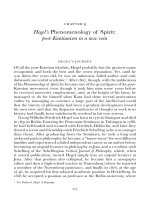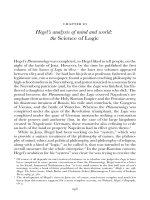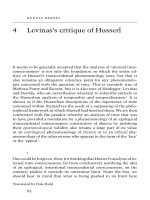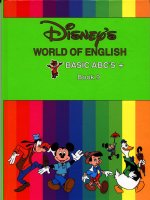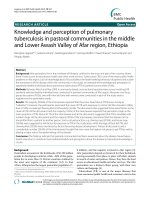Consumer’s perception of low product quality of saigon special in saigon beer alcohol beverage corporation (SABECO)
Bạn đang xem bản rút gọn của tài liệu. Xem và tải ngay bản đầy đủ của tài liệu tại đây (1.08 MB, 67 trang )
UNIVERSITY OF ECONOMICS HO CHI MINH CITY
INTERNATIONAL SCHOOL OF BUSINESS
Consumer’s perception of low product quality
of Saigon Special in Saigon Beer-Alcohol-Beverage Corporation
(SABECO)
Name: Tran Thi Thanh Huyen
ID: 221500030
MASTER OF BUSINESS (Honours)
Ho Chi Minh City- 2017
UNIVERSITY OF ECONOMICS HO CHI MINH CITY
INTERNATIONAL SCHOOL OF BUSINESS
Consumer’s perception of low product quality
of Saigon Special in Saigon Beer-Alcohol-Beverage Corporation
(SABECO)
Name: Tran Thi Thanh Huyen
ID: 221500030
SUPERVISOR: Dr. LE NHAT HANH
MASTER OF BUSSINESS ADMINISTRATION
Ho Chi Minh - 2017
Acknowledge
I would like to thank all of my family, friends and colleagues who inspired and supported me in
this thesis writing venture. I am really indebted to my supervisor Dr Le Nhat Hanh whose proper
guidance and close supervision helped me to carry out this research to the right direction. I
would also like to show my gratitude to all of respondents who shared their experiences with me,
thanks for all valuable time they have invested in this study that gave me precious information
for research. Last but not least, I would like to express my thankfulness to my company Sabeco, my Boss and all colleagues who supported me a lot during the time doing this research.
I
TABLE OF CONTENTS
EXECUTIVE SUMMARY………………………………………………………..…………...1
CHAPTER 1. PROBLEM IDENTIFICATION………………………………..……………..2
1.1 Background of the company…………………………………………………….…….…….3
1.2 Background of the problem…………………………………………………………….......7
1.3. Problem identifying..……..…………………………….……………………….….……..11
1.3.1. Problem justifying……………………………………………………………….………..11
1.3.2 Justify the existing of problem………………………………………….……….………..16
1.3.3. Definition problem……………………………………………………………….……….22
1.3.4. Justify the importance of the problem: literature regarding, consequence effect….…….23
1.4. Potential causes……………………………………………………….………..………….27
1.4.1. Opinions from other people……………………..…………………………………….….28
1.4.2 Situation…………………………………………………….……………………….…….29
1.4.3 Product physical properties………………………………………………………….…….29
1.4.4 Storage, use, and convenience of beer……………………………………………….…….30
1.4.5 Cause - effect tree………………………………………………………………………….31
1.5. Causes validation ………………………………………………………………………….32
CHAPTER 2. ALTERNATIVE ANALYSIS…………………………………………………36
2.1 Alternative Solutions………………………..……………………………………….……..36
2.1.1 To improve warehousing can adapt to these rule in preservation ………………….……..36
2.1.2 Invest on transportation vehicle beer suitable for ensure quality product………….……..38
2.1.3 Improving reasonable distribution network…………………………………………….….39
II
2.2 Solution comparison……………………………………………………………………...40
CHAPTER 3. ACTION PLAN……………………………………………………………….43
CHAPTER 4. CONCLUSIONS AND RECOMMENDATION…..……………………….52
REFERENCES ………………………………………………………………….……………..54
APPENDIX 1 …………………………………………………………………….……….……58
APPENDIX 2 ……………………………………………………………………….………….61
APPENDIX 3 ……………………………………………………………………….………….63
III
LIST OF FIGURES
Figure 1: Organizational system of SABECO
Figure 2: Market share of beer market in 2015
Figure 3: Market share of Sabeco from 2012 to 2015
Figure 4: Saigon Special did not choose much comparing to Heineken, Tiger by users.
Figure 5: Level of customer’s satisfaction Saigon special beer
Figure 6: Cause-and-effect tree
Figure 7: Model of determinants and consequences of perceived product quality
LIST OF TABLES
Table 1 : Company information
Table 2 : Market share of all products of Sabeco from 2013 to 2015
Table 3 : Sample details
Table 4 : Customer’s evaluation for Saigon beer report
Table 5: Technical requirement of Saigon Special beer
IV
LIST OF ABBREVIATIONS
- SABECO: Saigon Beer-Alcohol-Beverage Joint Stock Corporation
- HABECO: Hanoi Beer and Beverage Corp
- MoIT: Ministry of Industry and Trade
- BMI: Business Monitor International
- SATRACO : Saigon Trading Corporation
- SABETRANJSC: Sabeco transportation joint stock company.
- SABECUCHI: SABECO Cu Chi Factory
- QA: Quality Assurance
- VBA: Vietnam Beverage Association
V
EXECUTIVE SUMMARY
Beer industry has witnessed higher total volume growth despite the rise in the Special Consumption Tax
from 50% to 55% since 2016. Positive economic conditions in Vietnam have boosted consumers’
incomes and forced them to shift from unbranded to branded beer, as higher quality and taste. Saigon
Alcohol Beer & Beverages Corp (Sabeco) saw a reduction in its market share although it maintained its
lead in beer. Saigon Special is a new brand of SABECO that is aiming at the target segment of people
who tend to drink premium beer. Although at present SABECO is the leading beer producer with the
market share accounting for 39% in 2016 however the launching of its new brand Saigon Special was not
so successful because SABECO lacked of an effective distribution plan especially focusing on
preservation during transportation activities for this new brand. In exploring the weakness point of the
product, Saigon Special, we have given some recommendations to grow market share and market size by
investment into quality ptoduct to create the customer need.
Customers’ perspective of quality has been proven to be the primary element contributing to the success
of the company. In which, four important factors affecting customers’ perspective of quality are opinions
from other people, situation, physical properties and storage, use, convenience of beer. The purpose of
this thesis is to identify the root cause led to the main problem after analyzing all possible causes.
Strongly invest for retailer in terms of point of sales material (POSM), display (for short term) and invest
on distribution system in both policy and display, especially at point of sales (for long term). Finally it
implicates potential solutions that can be applied to solve this problem.
CHAPTER 1: INTRODUCTION
The first chapter presents an introduction to the research, as well as introduces about company
background and discusses the purpose, objectives and research problems of this company. Chapter Two
will present the literature review which explains the theoretical framework and give some solutions for
this research that will be used for the survey. In this chapter, the two main research methods, namely
quantitative and qualitative research, will be discussed. The third chapter will present the empirical
findings. Lastly chapter fourth wills conclusion and recommendations for companies and further studies.
1.1 Company background
SABECO is built in 1875. In June 1977, the factory was renamed as Saigon Brewery factory. In 1993
the factory was renamed as the Saigon Beer Company and became one of the company has the most
modern equipment in the beer industry in Vietnam. In July 2003, Saigon Beer Company expended and
became one of leading enterprises in the beer industry in Vietnam- Sabeco. In early in 2008 became
SAIGON BEER – ALCOHOL – BEVERAGE JOINT STOCK CORPORATION upon the government's
decision. For over 30 years of operation in the brewery, alcohol and beverage industry, SABECO has
developed to be market leader in Vietnam’s beer business in many respects.
Items
Company name, location.
Description
SAIGON BEER – ALCOHOL – BEVERAGE JOINT STOCK CORPORATION
6 Hai Bà Trưng, Bến Nghé, 1, Hồ Chí Minh
Website
Website :
Product
Main product classes Beer (main product), soft drinks, and
low alcoholic drinks.
Table 1: Company information
2
Achievements
SABECO recognized titles as of to date include: The brand name “Saigon Beer” has been recognized as
the “trusted brand” for 22 years; The “Saigon Beer” product has been repeatedly voted as a “High –
quality Vietnamese product” for 13 consecutive years from 1997 to 2012; The “333” canned beer product
won the Silver Medal at the international beer content held in Australia in years 1999, 2000, 2001.
SABECO business includes three main fields. First, manufacture and sale kinds of beer, alcohol,
beverage, packaging, label for beer, wine, soft drinks and food; Sales materials, equipments, parts related
to the production of beer, wine, soft drinks, assorted flavors, juice for the production of beer, wine and
soft drinks; food. Second, import and Export all types of: beer, wine, soft drinks, materials, equipments,
wine and soft drink. Third, provide training services, research, technology transfer, investment
consulting, construction, installation, repair and maintenance in the Beer - Alcohol – Beverage industry
and food. SABECO main products include 333 Can and Bottle Beer, Saigon Lager Beer (Sai gon Xanh),
Saigon Export (Sai gon Do) and Saigon Special Beer (Sai Gon Lun). Saigon Do, 333, Saigon Xanh are
among 15 best – selling products of 36 cities. Saigon Do takes first place in On – Premise channel while
333 Can become leader in Off – Premise Consumption. SABECO Vision to 2025 is to become “national
leading” Beverage Group, with high position in regional and international market”. By the end of 2016,
Sabeco included 23 branches and 21 co-owned joined ventures. A part of them are dealing only in beer
trading or indirectly connected to beer. The production capacity of the 23 breweries reaches about 1800
mln liters per year. In view of growing output volumes the company is investing into construction of new
breweries planning to bring their net capacity to the level of 2000 mln liters by 2020.
3
Missions
SABECO defines four Missions to follow, which are:
to develop Vietnam Beverage Industry to the world level;
to heighten Vietnamese culinary culture;
to improve Vietnamese life quality through the provision of high quality, safe and nutritious
beverage products;
to bring real benefits to shareholders, customers, partners, employees and society. SABECO
defines his core values into: Traditional Brands, Social Responsibility, Cooperation for Mutual
Benefits and Continuous Improvement.
The Organizational System
SABECO has a total of 23 subsidiaries and 21 associated companies and joint ventures operating in the
production chain (see Fig.1) as follows:
Production, supply and packaging materials .
Provide input transport services, logistics, warehousing and other auxiliary activities
Production and sales, distribution of beer, wine,
Investment in other industries, mainly construction and supply estate services lemongrass
4
Figure 1: Organizational system of SABECO
Supply
team
ProductionTechnology team
Marketing
team
InvestmentDevelopment team
FinanceAccount
team
SABECO
Investments
outside the
industry
SABECO NCT
SaiGon Cu Chi
FActory
Subsidiaries
Material-Packing
Manufacturing
Distribution
Commerce SABECO Ltp
Packing SG beer company
SG-MienTay Factory
SG-QuangNgai Factory
SG-DongXuan Factory
SG-NgheTinh Factory
Glass Malaya Company
SG-SongLam Factory
Packing Samiguel Phu Tho
Company
SG-HaNoi Factory
Commerce Northern
SABECO
Commerce North Central
Coast SABECO
Commerce Central SABECO
SG-SocTrang Factory
SG-PhuLy Factory
SG-PhuTho Factory
SG-TayDo Factory
SG-BinhTay Factory
SG-BacLieu Factory
Commerce Central
Highland SABECO
Packing- Warehouse BinhTay
Food’s SABECO company
Auxiliary company
KKjkkjCompanyCoexa
minationAPacking
Mechanical
company
Commerce South Cental
SABECO
Commerce East SABECO
SG-NinhThuan Factory
SG-VinhLong Factory
Commerce East Northern
SABECO
Commerce Tien river
SABECO
SG-KienGiang Factory
SG-DakLak Factory
Commerce HSABECO
BinhTay Wine Company
ChuongDuong Beverage
5
Transportation Company
1.2 Background problem
1.2.1. Current situation of Sabeco
Sabeco has been remained the leading position in beer industry despite the appearance of numerous beer
brands in Vietnam recently. According to Vietnam beer alcohol beverage association,1Sabeco has kept
the highest market share until 2015, followed by Heineken and Habeco. It takes about 43% of market
share while Heineken has 21.5% and Habeco with 19.7% (Figure 2)
Figure 2. Market share of beer market in 2015
However, although holding the first position in Vietnamese beer industry, market share of Sabeco has
been decreased continuously. Figure 3 shows that Sabeco gets the market share of 51.4% in 2012 (more
than 50% of total market), however it drops to 47.5% in 2013, 45.2% in 2014 and 43% in 2015. Over 3
years, its market share has been reduced up to 8.4%. 2
6
Figure 3. Market share of Sabeco from 2012 to 2015
The decrease of market share has posed an outcome of many problems. How to identify and
solve these problems to gain the market share again is the main objective of this thesis.
1.2.2. Current situation of Saigon Special beer
According to a research conducted by Sabeco in 2010, Saigon Special beer is a brand that belongs
to the first four brands out of list top ten most popular beers within 36 biggest cities in Vietnam. Its target
segment is Vietnamese people who prefer premium beer, white collar and from middle to high income. It
is the first brand oriented as a premium brand of Sabeco and positioned as high-end product which targets
to young and dynamic consumers. 3
Regarding the decrease of market share of Sabeco, Saigon special beer has been chosen as the
main product to this research because in comparison with other products like 333, Saigon export…
market share of Saigon special beer has been decreased continuously at the highest level, from 23.4% in
2013 to 19.8% in 2014 and 18.7% in 2015. 4
7
Table 2: Market share of all products of Sabeco from 2013 to 2015
Product
2016
2013
2014
2015
Saigon Special
23.4%
19.8%
18.7%
18.0%
333 beer
36.8%
36.7%
37%
37.5%
Saigon export
29.3%
30.2%
28.9%
29.3%
Others
11.2%
13.3%
15.4%
15.2%
Once customers can remember about the brand at their first thinking, it means that this brand has chance
to attract the purchase. This feature is the most important one of the evaluation about brand awareness.
According to the research of 2015 survey by major Japanese brewer Kirin Holdings Co, Vietnam, Saigon
special got 5.1% among 395 respondent for the question " What’s your most favorite brand beer” and
stood at number 5 in consumer’s top of mind .
8
The figure 4 shows that Saigon Special did not choose much comparing to Heineken, Tiger by users.
Customers can contact to customer support department for any questions or complaint’s information
during using period, they completely unsatisfied with the quality of product what did not meet their
desire. According to Kim Long Who is a food’s engineer working at Quality Assurance said that:
“Each year he received some of consumers’ complaints about quality to product. Until June, total is 6 cases
complaints from consumers. Among that have five cases related to quality product and one case is mistake of
packing. Detail to, five cases related to quality product , the consumer complain about physical characteristics
such as crusted beer, sour beer, ….He must be collect these mistake products from complainers and check again
9
quality product one more. Although, before delivering product to customers, the technical staff checked carefully
product status”.
Regarding yearly report of marketing team from customer support department, the level of customer
satisfaction was collected in period 2013-2016. The report showed the percentage of unsatisfactory of
SABECO’s customers was low level around 11%-22% during 03 years from 2013 to 2016. Nonetheless,
from year 2013 and later, it exhibited an increasing trend of unsatisfactory of clients.
Level of customer’s satisfaction Saigon special beer
80
70
60
50
40
30
20
10
0
Satisfaction
Normal
Unstatisfaction
2013
2014
2015
2016
The
figure 5: Level of customer’s satisfaction Saigon special beer
From these tentative problems are showed. The author continues make clear to find out the real problem.
So, the problem here is that what determinant factors affect perception quality consumer’s Saigon Special
beer in Ho Chi Minh City?
1.3. Problem identifying
1.3.1 Problem justification
In this part, the author will justify whether the thing is the real problem at SABECO for Saigon Special
product. Qualitative and Quantitative approach was adopted through secondary data, survey 40 people in
10
Ho Chi Minh City. A survey of consumer was carried out in which they were questioned about important
factors which affect beer consumption, brands of beer they consume and evaluation on Saigon Special
beer based on a range of factors linked to consumption. It is obvious to see that, for products in Food and
Beverage category, factors which determine product quality are still considered to be most important, not
only for elder consumer who has several experiences but also for the youth. Most previous study cannot
be summarize easily because of a lack of consistency across research findings and the different methods
and research designs used to identify attributes comprising product quality. 5 Normally, the importance of
a given set of attributes for a product category will be evaluated by consumers. Then, they will evaluate
the level to which each brand has those attributes. Their estimate of quality is obtaining the d by
multiplying the attribute's importance by the rated evaluation of the attribute, and next step, adding to all
of the attributes to obtain an overall product quality status. 6 Different authors have studied perceived
quality and preferences about beer using different approaches. According two author’s discussion about
the relationship between market share and customers’ quality perceptions, market share can influence
quality by creating positive network externality. In other words, when a product has positive network
externality, bigger market share brings higher quality perception of customer.7 According to the writer
that sometimes we are affected by other opinion’s people when we decide to buy a brand, because of,
more consumers buying this product which the brand is popular. And most of people not want to be
outdated. 8 The customers are easily affect to behavior buying, from that it effect to market share in
determining product quality. When there is no other information,. This is why market share is a
frequently used indicator for consumers to tell product quality.9 However, it is hardly reliable to judge
product quality by market share solely as products are diverse. It points out that product category
undoubtedly influences the impact market share has on quality perception. How does the researcher know
the consumers' impressions are accurate if only one measure is used? The validity of a construct is an
11
issue of measurement rather than definition. A valid measurement tool must be selected to make
operational a comprehensive construct for the meaning of product quality.10
1.3.2 Problem existing
Saigon Special was selected as a convenient illustration of some products in SABECO of product quality.
A wide selection of competitive brands is available for comparison, as well as varied intrinsic physical
differences of quality. A convenience sample of 40 respondents was chosen for this survey. However, the
results are only for illustration and are not representative of all consumers. The study design and
application are described in the appendix.
The customers' perceived product quality consist of both types of feature, extrinsic and intrinsic,
For that reason it was really essential to evaluate these two dimensions independently: the perceived
quality regard to the brand and the perceived quality regard to the intrinsic product characteristics. For
these quantify, we collected the consumer survey of potential buyers and paid attention to the technical
characteristics of Saigon special.
In the survey which connect with the “perceived quality attributed to the brand” (PQB) variable, the
writer will start doing the evaluation of the brands that consumers provided. in the detail, the surveyors
will give some directly question about the level of quality the consumers would ensign to each of the 8
brands in the question data, on a five-point Likert scale following already validated quality scales 11.This
procedure provided us with a separate score for each of the 8 brands that were offered for sale in the
study period. Therefore, we obtained a new enclosed variable; the values are between one and five, which
collects the average score of the perceived quality attributed to the brand, according our surveyed
consumers. As we searched and asked for the brand quality assessment, all products of a particular brand
have the same value for this variable.
12
With the “perceived quality attributed to the intrinsic product characteristics” (PQIC) variable, we
combined information related to the technical attributes and subjective information from the consumer
survey. First, for the Saigon special product, we search for the manufacturers' estimation of the four most
important intrinsic technical characteristics for paying for it (Mitra and Golder, 2006) 12. in this way, we
pick up enclosed values—between one and five—which collect the quality level of each these four
technical characteristics depending on their objective features.
Result of survey
After sending the questionnaires to 40 people, the author adequate data from primary research were
collected. As the results from our survey:
Table 3 : Sample details
1. Gender:
2. Age breakdown
3. Job status
male
85%
female
15%
Under 20
7.5%
20 - 25
30%
25-30
47.5%
Over 30
15%
Under – graduated student
20%
Having just graduated (< 6 month)
12.5%
Staff
13
Manager
50%
17.5%
4. Average monthly
Under 1.000.000 VND
spending for
1.000.000 VND - 2.000.000 VND
hanging out
12.5%
2.000.000 VND - 4.000.000 VND
35%
47.5%
Over 4.000.000 VND
5%
Total sample of 40 respondents comprised of 8 under graduated students, 5 having just graduated, 20
staffs and 7 working in management level, of whom 15 percent were female and 85 percent were male.
The age breakdown is: under 20 years (3 respondents, account for 7.5%), 20 – 25 years (12 respondents,
accounts for 30 percent) and 25 – 30 years (19 respondent’s accounts for 47.5 percent). Spend for
hanging out/relationship. Consumer only spend under 1.000.000 VND account for 12.5 percent,
1.000.000 VND - 2.000.000 VND account for 35 percent, 2.000.000 VND - 4.000.000 VND account for
47.5 percent , the remaining are willing to spend over 4.000.000 VND for the same purpose.
There is 70% of customer drink beer every week, 2.5% of them only drink after more one month (2-3
months), 7.5% respondents drink in a month and 20% remaining drink every day, especial that there no
respondent is never drink beer.
For the consumers, product physical properties - functional factors that determine the quality of the
product, are the most important factors leading to the choice of products. In which has average score of
"5" is very high. Also for the consumer, two factors from Saigon special beer that satisfied them most are
“price” (mean point 4) and “brand name” (mean point 4). Other factors influence the selection of beer
14
products are "brand" (mean point 3), "other opinions" (mean point 3). Despite of not taking the highest
score, those emotional factors still significantly impact the choice of consumer products and should be
study carefully by marketer.
The impact of brand name also play important role in their consuming decision with mean point (4) This
is the reason why the percentage “High” and “very high” of Heineken and Tiger in consumer drinking
list is highest one (95%). Besides, the percentage “High” and “very high” of Saigon special beer just list
is (30%) although approach the same premium segment. Therefore, continue improving factors which are
considered to be Saigon special beer’s strength on satisfying this market, Saigon special beer need focus
on building up the dynamic, modern image to be friendlier to consumers. The consumer estimate brands
mainly selected are in table 3 : Assess the quality of these brands according your opinion.
Brand
Heineken
Very low
0%
Low Regular High Very high
0%
5%
60%
35%
Tiger
0%
0%
5%
80%
15%
Sapporo
0%
10%
25%
45%
20%
333
0%
15%
50%
20%
15%
Hanoi beer
5%
20%
65%
10%
0%
Huda beer
5%
30%
55%
10%
0%
Saigon Special beer
0%
15%
55%
25%
5%
From that 70% respondents assess the quality of Saigon Special is low and regular. I suggest that they
should examine which factors affect perceived quality of their products by surveying the consumer’s
opinions, or using the qualitative research methods, such as interviews. These approaches will make them
15
understand customers more deeply. The determinants of perceived product quality can be divided into
two types. One is intrinsic cues that are physical characteristics of the product itself including size, color,
flavor, appearance, or aroma. Second are the extrinsic cues which are external to the product itself, such
as price, brand image, manufacturer’s image, retail store image, or even the country of origin. Almost of
consumers can use these physical characteristics to judge product quality in the interview (see appendix
2). Following the result of interview, customer has more power of understanding about the product which
has right characteristics, quality of Saigon Special beer. Focusing on quality can help a business maintain
a satisfied customer base. Among 24 answers of 24 respondents who assesses the quality of Saigon
Special is not good, they feel the flavor, aroma, taste, smell, and color of this product is not stability. And
these quality is not response the expectations of consumers.
1.3.2. Problem definition
There are various academics defining the concept of perceived quality. According to the researcher said
that “the concept of perceived product quality is defined to include the consumer's response to the entire
evoked set of judgments about quality comparisons among competitive brands”. 13 This definition has a
some different compare with the current practice of conception product quality on the basis of a
multidimensional list of product attributes to make the construct operational. Normally, the importance of
a given set of attributes for a product category is asked to evaluate by consumers. Then, they evaluated
the level to which each brand has those attributes. Their estimate of quality is obtained by multiplying the
attribute's importance by the rated evaluation of the attribute, then summing across all of the attributes to
obtain an overall product quality score
The customer’s perception created by the companies through the advertising publicities, and other social
media intend to purchase the product. In the main, the feeling of customer about product quality and its
16
characteristics provided to them such a performance and reliable of the product. The evidence of quality
product is made by the brand product to meet the strong belief of the customers. 14
In point of fact, actual or objective quality is different from the perceived quality, product-based quality,
and manufacturing quality. 15 It can be viewed as the difference between overall quality and undetected
quality. In addition, perceived quality may lead to consumer satisfaction, which is determined by
perceived performance and expectation. 16 In spite of the fact that there has more concepts from many
authors, each of the definition has the same meaning; that is, perceived product quality is the consumer’s
perception quality of overall components of product both tangible and intangible characteristics. It may
also include performance, features, reliability, conformity, durability, serviceability, and aesthetics etc.
Above all, it is different from the actual quality of products.
1.3.3. Justify the importance of the problem: literature regarding, consequence effect
The perceived product quality has a powerful effect on various variables about business’ performances
which can be described as follows:
Profit margins
The pronouncement is from research of the Profit Impact of Market Strategy (PIMS) database developed
at the Marketing Science Institute and the Strategic Planning Institute in Cambridge widely identify as
the only complete database in the world of strategic information on many different industries. Studies on
the PIMS database dramatically determine that market-perceived quality has the relationship with return
on sales positively.17
17
Brand Power and Market Share
Stobart 17 said that brand power and dominant market share is result of good perceived product quality.
How the entrepreneurs and managers can make popular brands. They must start with a clear understand
of needs and demand of a well-defined group of customers. They manufacture products and supply the
related services that meet those needs exceptionally well. Effective ‘quality control’ measures ensure
they do things right the first time in delivering those products and services. Therefore, they reach to
higher quality in areas that matter to the customer together with a cost structure no higher than that of
lower-quality competitors. Then, they notify to share with their products’ advantages. The customer
perceives the quality and the exceptional value are suggested.
Brand Equity
Aaker 15 stated that perceived product quality is one of the factors important of brand equity . Perceived
quality will directly affect purchase decisions and brand loyalty. Specially, when a customer is not
motivated or able to conduct a detailed analysis. It can also support a premium price which,
successively, can make a gross margin that can be reinvested in brand equity.
Perceived value
In addition, perceived product quality affects perceived value because it gives value in some ways.
Firstly, in many conditions, perceived quality of a brand provides a critical reason-to-buy, influencing
which brands are included and excluded from consideration, and the brand that is to be selected. A
customer often will lack the motivation to obtain the information that might lead to an objective
determination of quality in given application. Occasionally, the information may simply be unavailable
or the customer may not have the ability or resources to obtain. In many cases, perceived quality
becomes important in the customers’ decisions.
18

